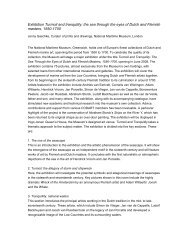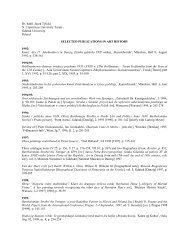Courant 8 - CODART
Courant 8 - CODART
Courant 8 - CODART
You also want an ePaper? Increase the reach of your titles
YUMPU automatically turns print PDFs into web optimized ePapers that Google loves.
25 codart <strong>Courant</strong> 8/June 2004<br />
figure drawings: biblical narratives by<br />
Maarten van Heemskerck (The parable of the<br />
great supper, 1569) and Karel van Mander (The<br />
conversion of Paul, 1587); a mythological scene<br />
by Hendrick Goltzius (Diana and the nymph<br />
Callisto); and studies for drawings by Jacques<br />
de Gheyn iii(Nude studies) and for a sculpture<br />
by Adriaen de Vries (Apollo). A large group of<br />
18th-century landscapes, whose artistic<br />
quality fails to match that of the works listed<br />
above (Hendrik Spilman, Leendert Brasser), did<br />
not find its way into the present exhibition.<br />
Although larger than in most of the<br />
aforementioned institutions, the collection<br />
of Netherlandish drawings in the National<br />
Museum in Warsaw contains items varying<br />
in provenance and artistic value. These were<br />
either purchased or came to the museum as<br />
donations or permanent loans, for example<br />
from the priest Józef Mrozowski in 1908,<br />
Mathias Bersohn (1823–1902) in 1916, or from<br />
Seweryn Smolikowski in 1927. The museum<br />
was established in 1862 as the Museum of Fine<br />
Arts and has been known under the present<br />
name since 1916. After the Second World War,<br />
in which roughly half of the collection was<br />
destroyed, the museum acquired the holdings<br />
of the Society for the Encouragement of Fine<br />
Arts in Warsaw, including the notable bequest<br />
of Jan Gottlib Bloch (1836–1902), as well as the<br />
collection of the former Schlesisches Museum<br />
der bildenden Künste in Breslau and the<br />
album Dessins Originaux, which had been kept<br />
in the local Stadtsbibliothek. Of special<br />
interest in this group are two drawings by<br />
Ferdinand Bol – Saul visiting the witch of Endor<br />
and Abraham’s sacrifice (the latter not included<br />
in the exhibition); two sketches for the print<br />
Land-yacht by Jacques de Gheyn ii; Singing old<br />
woman by Gerrit van Honthorst; and two<br />
sheets by Crispijn van den Broeck, Resurrection<br />
and Pentecost. Among the most noteworthy is<br />
the set of figure and landscape studies by and<br />
after Cornelis and Herman Saftleven (three<br />
works have been selected for the exhibition)<br />
and several drawings by Jan de Herdt, a<br />
Flemish artist active in Italy, Austria, Moravia<br />
and probably Silesia whose works are<br />
exceedingly rare. (One will be presented in the<br />
exhibition.)<br />
Despite its small size, the collection of<br />
Dutch and Flemish drawings in the National<br />
Museum in Poznan´ is among the most<br />
valuable, largely because of Rubens’s Rest on the<br />
flight into Egypt, and his design for a woodcut<br />
by Christoffel Jegher (property of the<br />
Dzial-yn´ ski Foundation), in which the<br />
draftsmanship of the ‘Prince of Painters’ found<br />
its supreme expression. These are matched in<br />
excellence by the exquisite series of the Twelve<br />
months by Lambert van Noort and Maarten van<br />
Heemskerck’s Abraham and Sara leaving Egypt<br />
(1549). Equally small in number and also of<br />
high quality are the works in the collection of<br />
the Museum of the Czartoryski Princes in<br />
Kraków, which was assembled mainly by<br />
Ladislaus Czartoryski (1828-1894) in Paris, and<br />
was further enlarged by later acquisitions and<br />
an 1897 donation by Bolesl-aw Wol-odkowicz.<br />
Works from this collection presented in the<br />
exhibition include a winter landscape by van<br />
Goyen as well as Adam and Eve by Johan Wierix.<br />
Most noteworthy in the modest collection<br />
of Netherlandish drawings held in the<br />
National Museum in Wrocl-aw are the<br />
religious scenes by Willem van Mieris the<br />
Younger, two of which have been selected for<br />
exhibition, together with Abraham<br />
Bloemaert’s putti. (This collection includes<br />
parts of the former holdings of the Schlesisches<br />
Museum der bildenden Künste.) The selection<br />
was completed with excellent, though rare,<br />
works from the Jagiellonian Library (Philips<br />
Koninck); the Wawel Royal Castle (Abraham<br />
Diepenbeeck) in Kraków; and the National<br />
Library in Warsaw (Jacques de Gheyn ii).<br />
The Warsaw exhibition will offer an<br />
overview of all major artistic trends and circles<br />
working in the Low Countries throughout the<br />
16th to the first half of the 18th centuries.<br />
Hence the absence of some great names (such<br />
as Pieter Bruegel the Elder, Bartholomeus<br />
Spranger, Jan Brueghel the Elder, Anthony van<br />
Dyck, Willem van de Velde the Younger)<br />
– the result of gaps in Polish collections and<br />
preservation considerations – was not a major<br />
obstacle in executing the project. Polish<br />
collections hold hardly any 15th-century<br />
Netherlandish drawings, and the best of the<br />
few present, Female heads by Gerard David in<br />
the Museum of the Czartoryski Princes in<br />
Kraków, could not be displayed due to<br />
preservation considerations. Consequently,<br />
the only works representing the so-called<br />
Flemish Primitives are a St. John from the<br />
Ossolineum, which is associated with Dieric<br />
Bouts, and a Transfiguration by an unidentified<br />
artist from ca. 1500 (from the National<br />
Museum in Warsaw).<br />
The 16th-century section of the exhibition<br />
will open with a group of Renaissance figure<br />
drawings (Pieter Coecke van Aelst, Lambert<br />
Lombard, Jan van Scorel); this will be followed<br />
by a large and varied group of early Mannerist<br />
sheets (Maarten van Heemskerck, Lambert van<br />
Noort, Crispijn van den Broeck, Marten de Vos,<br />
and the workshop of Frans and Cornelis Floris)<br />
and the first examples of landscape drawing,<br />
some with landscape only, others combined<br />
with genre or biblical scenes (Master of the<br />
Months of Lucas, Master of the Prodigal Son,<br />
Cornelis Massys, Hendrick van Cleve iii, Joris<br />
Hoefnagel’s View of Andernach on the Rhine).<br />
Clearly distinguishable in the group of late<br />
Mannerist works (Lodewijk Toeput, Jan van<br />
der Straet, Jan Wierix, Joos van Winghe, Denys<br />
Calvaert, Pieter de Witte) is the international<br />
trend, represented by drawings by<br />
Johan Wierix, Adam and Eve, Princes Czartoryski Foundation at the National Museum, Kraków.


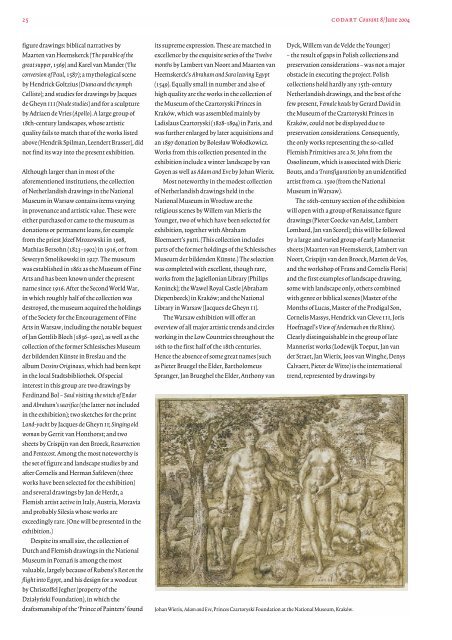
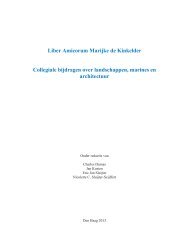
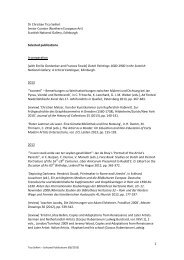

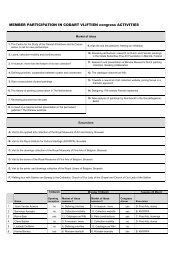

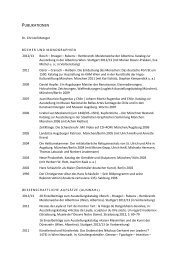

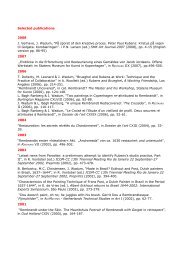
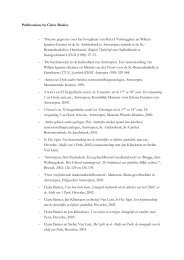
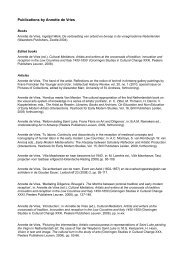
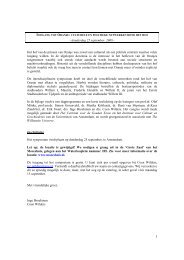
![curriculum [wim] - CODART](https://img.yumpu.com/19451661/1/184x260/curriculum-wim-codart.jpg?quality=85)
![curriculum [wim] - CODART](https://img.yumpu.com/19451660/1/184x260/curriculum-wim-codart.jpg?quality=85)
